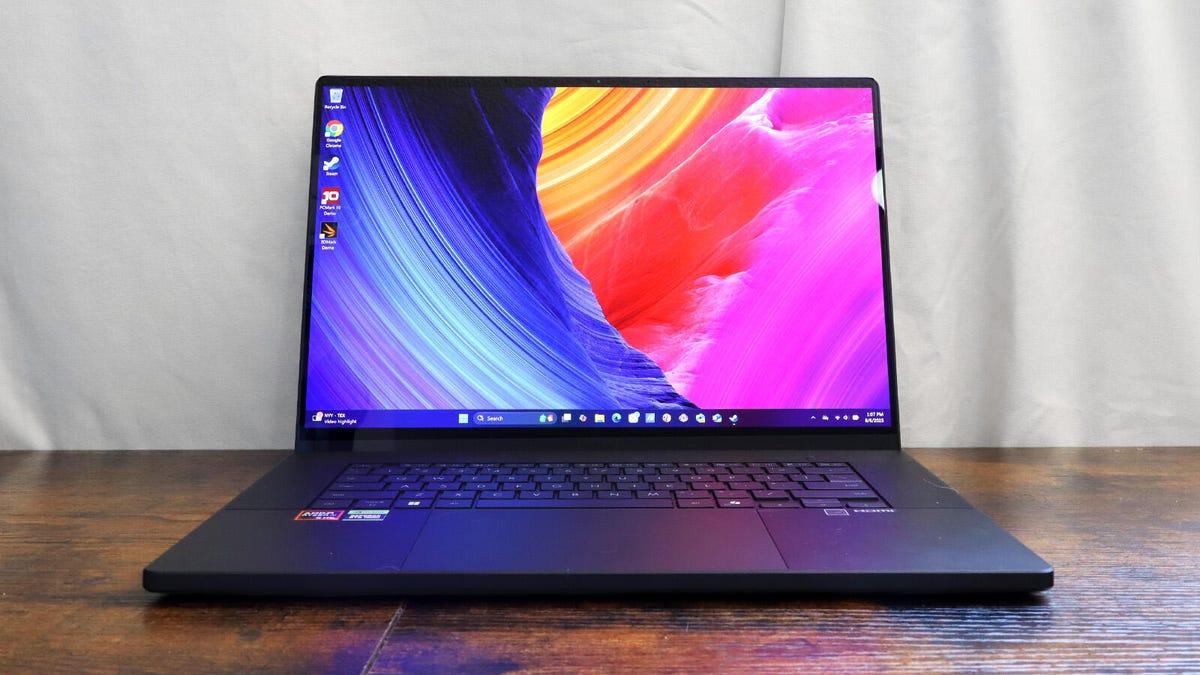Choosing the Right Laptop for Creative Work and Future-Proofing Your Investment
2 Sources
2 Sources
[1]
Choosing a creative laptop - how powerful does my creative laptop need to be?
How to configure a laptop for graphic design, 3D modelling, rendering, video editing and more. There's plenty to ponder when choosing a laptop for digital creative work, from which CPU, GPU, SSD and memory you need. But what components actually matter for graphic design, video editing, 3D modelling, rendering or digital art? In short, how much performance do you actually need? And how much do you really need to spend? CPU performance matters pretty much across the board, albeit you don't necessarily need the very highest specification chip for all creative workflows. On the other hand, how much memory, GPU power and storage performance and storage space you need can vary quite a bit by task type. For instance, if you're dealing with large 4K video edits, you'll want plenty of fast storage and a heap of RAM, while 3D animation will benefit form a really fast GPU and high resolution image editing wants a combination of decent CPU and GPU power, though arguably doesn't need absolutely bleeding-edge chips, plus plenty of memory. Horses for courses, chips for particular chores, however you style it, choosing your laptop wisely will save you money and make your workflows faster and more efficient. For more focused guides read our lists of the best laptops for graphic design, best laptops for 3D modelling and best laptops for drawing. Below I pick the core creative work types, detail the overall tech you'll want from a laptop and then recommend the best laptops. For most 2D workflows, you don't need the absolute last word in either CPU or GPU performance. Most modern mid-range or better laptop CPUs from AMD or Intel will get the job done pretty nicely. On the Intel side, anything from the last two generations with four Performance cores will be plenty, for instance a Core i5-13500H from Intel's 13th Gen series or the Core Ultra 5 125H from its latest 14th gen line. From AMD's CPUs, most chips from the Ryzen 6000 series starting with the Ryzen 5 6600H, a six-core model, and upwards will be plenty, though newer models including the latest Ryzen AI 300 series will give more performance and perhaps more importantly more future proofing. An entry-level GPU from AMD or Nvidia will do, too, though we generally favour Nvidia for broader application and plugin support and a better feature set. A last-gen Nvidia RTX 3050 Ti will be fine for less demanding workflows, as will something like an AMD RX 6600M GPU. That said, we'd still advise stretching to an entry-level Nvidia RTX 40 series GPU if you can. They offer that little bit more performance and future proofing and will give you more options should your creative horizons expand in future. As for memory, 16GB is a reasonable base level for the budget conscious and will cope fine with light to medium-duty design and image editing tasks. 32GB could come in handy if you're working with more complex designs or dealing with large batches of high res or RAW images, however. Storage will depend on your workflows to some extent. Most decent laptops from big brands come with decently fast PCIe Gen 4 NVME solid-state drives these days. So, it's mostly a case of making sure you have enough storage for the media and resources you deal with in a given workflow. And don't forget that you can use a fast USB-C drive to provide mass storage. You don't necessarily need endless terabytes of internal laptop storage. For good video editing and encoding performance, you need a little bit of everything. That means a decent CPU, a discrete GPU, plenty of memory and a quick SSD. Of course, maxing everything out doesn't come cheap. Instead, we recommend a minimum spec of a mid-range CPU with six performance cores or more. From Intel's latest 14th Gen mobile line, that means a Core 7 Ultra 155H, which has six Performance and eight Efficient cores, and up. From AMD's CPU lineup, you'll likely be looking at a chip from the 7000 Series or newer and we'd lean into an eight-core model if possible. So, models starting with the Ryzen 7740HS from the 7000 series, with equivalent models from the 8000s Series offering similar performance. If money is little object, AMD's latest Ryzen AI 300 series with 12 cores are absolutely killer. 16GB of memory will be fine for most mainstream video editing workloads. But if you can stretch to 32GB, that will give you headroom should you upgrade in future to really demanding timelines with high bitrate 4K video and various effects and filters. Video editing and most encoding tasks also benefit from GPU acceleration. Nvidia's laptop GPUs definitely have the edge at the moment when it comes to video editing application support and performance. Nvidia's latest RTX 40 series is the obvious pick. Even the base RTX 4050 GPU will have a noticeable impact on performance, but the RTX 4070 arguably the best bang for your buck. If money is no object, the RTX 4080 and 4090 GPUs will positively tear through encode jobs that offer full hardware GPU acceleration support. Storage wise, the higher resolution and larger the files in your editing timeline, the more space you'll need. However, arguably the latest USB-C external drives reduce the pressure on internal SSD storage. You may only feel the need to have enough space for your ongoing workflow, rather than using your laptop's drive for general storage. Still, a minimum of 1TB is wise for video editing and check the specification of the drive. Ideally, you want to aim for a minimum of 4-lane PCIe Gen 4.0 and TLC rather than QLC flash memory chips. When it comes to digital animation and 3D rendering, a decent GPU makes all the difference. Nvidia's mobile graphics currently offer comfortably the best combination of performance, driver updates and application and software support, especially for animation and 3D rendering. Nvidia's latest RTX 40 series GPUs have the most up to date feature set, though it's worth bearing in mind that the all-new RTX 50 series is likely to be announced later this year with the first RTX 50 laptops probably going on sale around spring 2025. If you're on a tight budget, even the entry-level RTX 4050 has a good feature set, albeit with relatively limited performance. The RTX 4070 offers a solid upgrade option, however for demanding workflows, its 8GB of VRAM can be a limitation. You'll have to step up to the RTX 4080 for 12GB or the RTX 4090 for 16GB. The latter doesn't offer a huge step up in terms of raw processing punch. But the extra memory can help to keep the full workflow in VRAM, which is much faster than having to dip into system memory to access resources and assets. CPU performance is also important for rendering, animation and 3D art, though the impact will vary from application to application and will hinge to a large extent on what proportion of a given workflow supports hardware GPU acceleration. For those with limited support, the fallback is CPU performance. Upper-middle to upper tier CPU models from the last two the three CPU generations from Intel and AMD with at least six full-performance cores all offer lots of punch. But our outright pick would be the new AMD Ryzen AI 300 chip. It offers a killer combination of 12 CPU cores, plus a powerful NPU. That NPU is probably of limited use today, but could come in handy as AI-accelerated tools become more commonplace. Alongside the CPU, 16GB should be viewed as a bear minimum these days and will be adequate for many 3D animation and rendering tasks. But 32GB is what you should be aiming for when it comes to pro-level workflows. Storage demands for these kinds of 3D digital content creation tasks vary substantially. But certainly don't skimp on a 512GB or smaller SSD. Aim for at least 1TB of Gen 4 PCie NVMe solid-state storage.
[2]
How to future-proof your back-to-school laptop
Everything you need to know to ensure your laptop will last longer than your course. If you've realised it's suddenly time to head back to school and your laptop is no longer up to the job, then a future-proof laptop might be just what you need. A back-to-school laptop is a big investment, even with a good deal, so it can make sense to choose one that will last for longer than just your course of study - ideally into your professional career. A future-proof laptop will have enough power, memory storage and other features to last for years - or will at least provide the flexibility for laptop upgrades as and when you need them. Ultimately, the best back-to-school laptop for you will also depend on what you're studying (we have dedicated guides to the best laptops for graphic design, the best laptops for CAD and best Mac for video editing) to help there). However, in the meantime, read on to learn everything you need to know about ensuring your new laptop (or your existing one) will last you well. Let's first considering whether it actually makes sense to buy a future-proof laptop. Buying a super high-spec device is likely to cost you more than what you would pay for laptop that has the minimum specs you need today. In many cases, that investment is likely to pay off because the chances are that you'll need higher specs in the future, but that a more powerful processor, higher RAM and storage or a higher resolution screen with more professional colour coverage. But there are arguments in favour of buying a cheaper laptop and replacing it every few years, however wasteful that might seem. Things move fast, and if you're going into a very tech-dependent profession, you might want a new device with more modern features not that so down the line anyway. The speed of development in AI, in particular, means that in a couple of years, laptops may have new optimised tech that simply isn't available today. Also bear in mind that people often end up replacing their laptops for reasons other than them becoming too old and slow for their needs: often because of accidents or physical damage to things like keyboards, screens and ports. A laptop with a Nvidia RTX 4080 mobile GPU rather than a 4060 isn't guaranteed to have a longer lifespan, and it could cost up to around $1,000 more in initial cost. That said, many creatives don't see their computing needs change massively from one year to the next other than the power, memory and storage required of the software they're using. If you buy a laptop with top-end specs today, it's feasible that it could last you for many, many years if you treat it well. So what do we even mean by future proof? Basically, we're talking about buying more than what you need today with the idea that it will last you longer. When it comes to laptops that often means taking into consideration that the type of work you might be doing or the software you'll be using in two or three years time, which may demand more powerful specs or superior features than what you need today. This will often mean choosing a processor that's a more powerful than what you need, along with more memory and a larger SSD for storage. Depending on what you're studying, you might find a laptop with 8GB of RAM and 256GB of storage space to be adequate for you needs, but by the time you start working professionally, you could find yourself getting frustrated with its capabilities. But a futureproof laptop isn't all about internals. There's also the overall build to think about. A well-built device is likely to resist a few knocks, and the keys are more likely to survive years of hammering. The screen is another consideration. If you go on to work in design or video professionally, you might find yourself wishing you had invested in a laptop with a more colour-accurate screen. Good candidates for future-proof back-to-school laptops today include the Asus Zenbook 14 OLED, Asus ProArt PX13 and the MSI Prestige 16 AI, all of which we gave 4.5 stars in our own reviews. Artificial intelligence is revolutionising all kinds of tech, and laptops are no exception. As well as CPUs and GPUs that are optimised for AI, the best AI laptops have a newer type of component called a neural processing unit or NPU. These specialised accelerator chips make clever use of AI to run certain creative software more efficiently, and they power tasks like voice and facial recognition, predictive analytics, and native machine learning on device without needing cloud-based AI services. The uses for NPUs are likely to grow in future years, helping to automate repetitive tasks, provide intelligent suggestions, and enable seamless voice controls, otentially changing the game in terms of productivity. This is one of the biggest changes in laptop tech in recent years, and it's an area where non-AI laptops might soon start showing their age. If you've decided to future-proof your laptop, that generally means going for a top-end laptop today with the idea that it will last for many years. For creatives, this will often mean going for a Apple MacBook or a Windows laptop with a hefty amount of RAM and storage. This means paying close attention to specs when you buy. Apple MacBooks remain hugely popular among creatives, but the base configurations aren't very future-proof for creative work at all. Even the MacBook Pro starts at just 8GB in RAM on the 14-inch model, which means it could be frustratingly lacking for memory-intensive workflows even today. Choosing enough RAM is particularly important for Macs since memory is soldered to the mainboard, which prevents them from being upgraded. That means you should buy a configuration with all the memory you will ever need. Even if you decide to replace the laptop yourself, higher memory can make it easier to sell you MacBook on. Windows laptops are more flexible, and you do have the option to open them up and upgrade components to extend their life. The brand Framework makes upgradability a big selling point, with a modular design that allows users to easily change and upgrade everything from the screen bezel to the motherboard and ports with no technical skills (see our Framework review). Continual advances in technology mean that even the most powerful laptop will feel outdated eventually, but that doesn't necessarily mean having to buy a new one. Fortunately, there are some easy ways to upgrade a laptop without even opening it up. Using peripherals: an external mouse, keyboard and/or monitor can provide better ergonomics and help an aging battery last longer. If it's power and memory that's the problem, you'll need to open your device. With Macs, your options are severely limited, but with a Windows laptop, almost many components can be upgraded if necessary. Processors (CPUs) are often soldered to the motherboard, making them difficult to replace, but changing or adding hard drives, RAM chips, graphics cards, wireless networks cards and sound cards is often viable (depending on what laptop you have, certain components may be easier or harder to get to in order to upgrade them). Laptops will usually have multiple slots for memory upgrades or installing additional SSDs for storage space, and this is something to consider when you choose your laptop in the first place. How you choose to upgrade your laptop will depend on what you think it needs. If you find it struggling when you have a lot of windows open or when you're working in lots of layers software like Photoshop, then you might find you need more memory. This will require changing or adding a RAM chip. Video editors or keen gamers may need more graphical processing power, so they may want to upgrade the graphics processing units (GPU). Storage is another laptop upgrade to consider. Many creatives use external SSDs, many of which are handily portable, but installing a bigger internal SSD can be more convenient if you find you need to be connected to more storage space most of the time. To upgrade your laptop, you'll first need to identify compatible parts, which will require checking your laptop's guidelines. Find your laptop's model information (often printed on the bottom) and download the manual if you don't have it. You'll also want to check what specs you system currently has (Go to Settings > System > About > "Device specifications" in Windows 11) Bear in mind that there are risks involved in upgrading a laptop yourself. You may accidentally damage components, and installing incompatible hardware, software or drivers can cause problems. If your device is still under warranty, that warranty may become void if you try to upgrade it. If you do go ahead and upgrade your laptop yourself, be careful to avoid materials that generate static electricity. Consider using an anti-static wristband. For more advice, see our guide to the most powerful laptops and the best MacBook Pro alternatives.
Share
Share
Copy Link
A comprehensive guide on selecting a powerful laptop for creative tasks and ensuring it remains relevant for years to come. This article combines insights on laptop specifications for creative professionals and tips for future-proofing your device.

The Power Requirements for Creative Laptops
When it comes to choosing a laptop for creative work, power is a crucial factor. The demands of creative software require robust hardware to ensure smooth performance. According to industry experts, the key components to consider are the processor, RAM, and graphics card
1
.For processors, Intel Core i5 or i7 are recommended for most creative tasks, while the i9 is suggested for high-end video editing. In terms of RAM, 16GB is considered the minimum for creative work, with 32GB or more being ideal for demanding applications. Graphics cards are essential for tasks like 3D rendering and video editing, with dedicated GPUs from NVIDIA or AMD being preferred over integrated graphics
1
.Future-Proofing Your Laptop Investment
Investing in a laptop that will remain relevant for years is a smart strategy, especially for students and professionals. Here are some key considerations for future-proofing your device
2
:-
Opt for higher specifications: Choose a laptop with specs above your current needs to accommodate future software updates and more demanding applications.
-
Prioritize upgradability: Select a laptop model that allows for easy upgrades of RAM and storage, providing flexibility for future enhancements.
-
Consider port selection: Ensure your laptop has a variety of modern ports, including USB-C and Thunderbolt, to support future peripherals and connectivity options.
Balancing Performance and Portability
While power is important, portability should not be overlooked. Many creative professionals need to work on-the-go, making laptop weight and battery life crucial factors. Ultrabooks and thin-and-light laptops offer a good balance between performance and portability, often featuring powerful components in sleek designs
1
.Related Stories
The Role of Display Quality
For creative work, display quality is paramount. Look for laptops with high-resolution screens, good color accuracy, and wide color gamuts. Many professionals opt for 4K displays, although this can impact battery life. Some laptops now offer OLED screens, providing excellent color reproduction and contrast
2
.Storage Considerations
Fast storage is essential for creative workflows. Solid-state drives (SSDs) are now standard in most high-performance laptops, offering quick boot times and rapid file access. Consider laptops with at least 512GB of SSD storage, with the option to expand or use external drives for larger projects
1
2
.By carefully considering these factors, creative professionals and students can select a laptop that not only meets their current needs but also remains capable and relevant for years to come. Remember, while it's tempting to focus solely on raw power, a balanced approach considering portability, display quality, and future upgradability will likely yield the best long-term results.
References
Summarized by
Navi
[2]
Related Stories
Recent Highlights
1
OpenAI releases GPT-5.2 AI model after code red memo targets Google's Gemini 3 threat
Technology

2
Disney invests $1 billion in OpenAI, licenses 200+ characters for Sora video generator
Technology

3
Disney accuses Google of massive copyright infringement through AI-generated character images
Policy and Regulation








